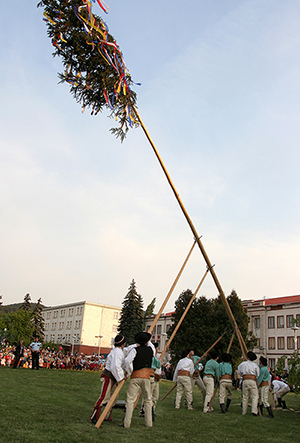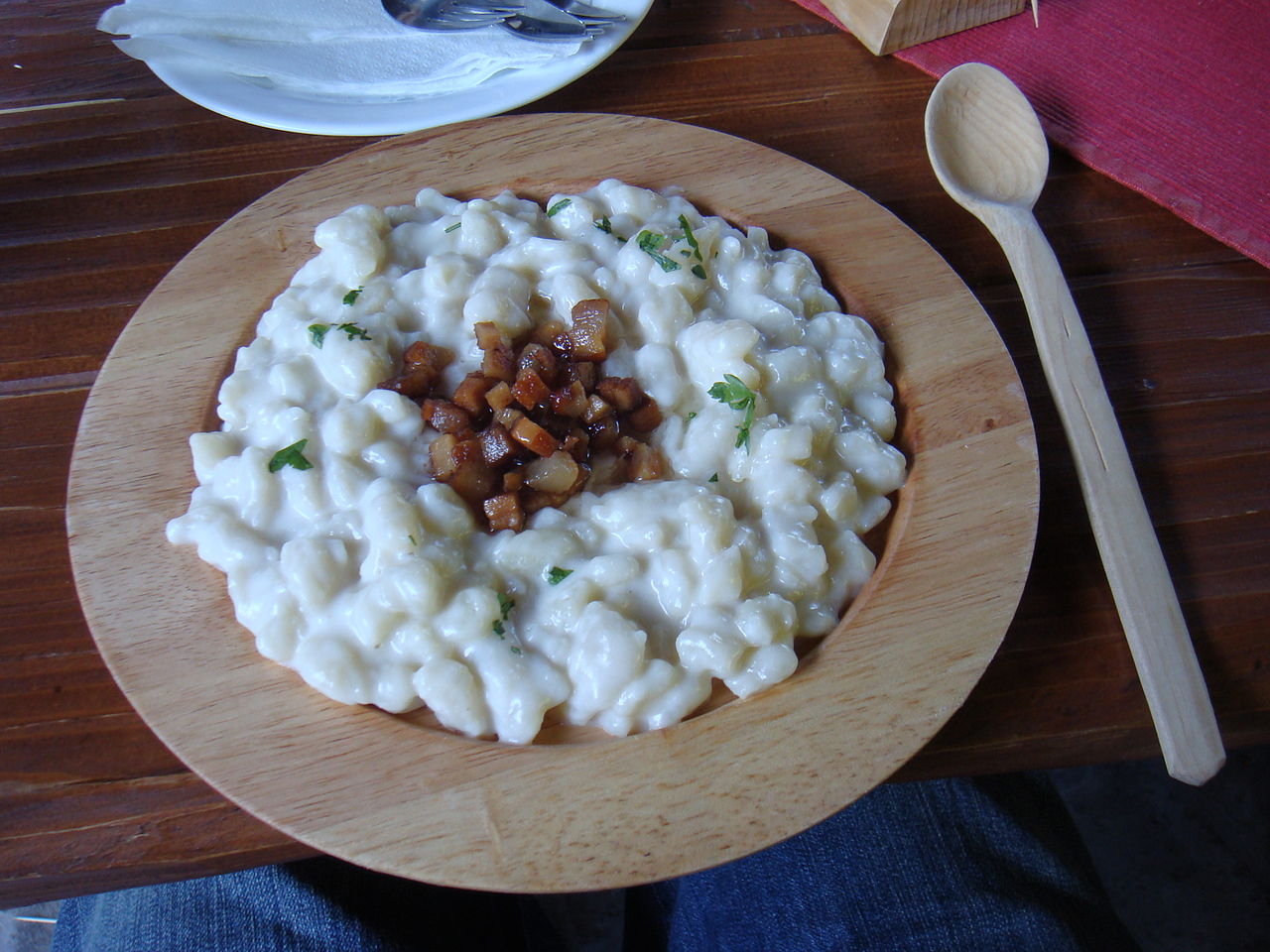About Slovakia
Slovak folklore
Slovakia is proud of its rich folklore and folk traditions. Each region, city, and municipality has a unique character and folklore – costumes, music, songs, architecture, customs, traditions, dances and dialects. Folklore festivals organised all around Slovakia serve to present the folk customs of individual regions.

The largest folk festivals in Slovakia are held in the towns of Východná, Myjava, and Detva, and all three festivals are organised under the auspices of C.I.O.F.F. (the world's largest folklore organisation). Other festivals are more regional in nature, but their quality is usually comparable to that of these three festivals. Generally speaking, there are significant differences among festivals, and each has its own distinctive atmosphere and charm. During the best festivals the whole village, city, or even the whole region follows the festival, and you can feel folklore at every turn.
Read more information about the largest folklore festival in Východná.
Customs and traditions
Folk customs and traditions long affected the life of our predecessors. The birth of these customs is usually rooted in fear of the unknown, an inability to explain natural events, as well as an attempt to achieve happiness, health or beauty. These uncertainties were the origin of many superstitions, myths and legends. Most customs were related to birth and death.
As our predecessors were living in close connection with nature, the customs and traditions of the Slovak nation are particularly related to the natural cycle, especially the customs from the pre-Christian period. With the arrival of Christianity, new customs and traditions took hold around Christian holidays. Customs and traditions always had a regional character; they were linked to a specific region of Slovakia. You could say that for each village, there was a set of customs.
Many of the customs have survived to the present day. For example, the {b}carrying of Morena{/b} (in the form of a straw effigy dressed in woman’s clothing) symbolises the end of winter and the arrival of spring. Young girls carried Morena to a local stream, undressed it on the bank, set it on fire and threw it in a stream.
On January 6th, boys go from door to door dressed up as the three Wise Men, singing carols and performing the Twelfth Night play, describing the visit of the three Wide Men after the birth of Jesus in Bethlehem, following a star. **Epiphany** marks the end of the Christmas school holidays and the beginning of a new season called Shrovetide.
**Shrovetide** was always a season of entertainment and feast, and it culminated with a carnival representing different animals. Shrovetide ended with a "burial of a contrabass", a parody of an actual burial. After Shrovetide, Christians observe Lent, a forty-day period of fasting (simple foods, no entertainment, etc.) leading up to Easter.

The most important Christian holiday of the year is **Easter**. The Easter holiday is celebrated differently in individual regions. In the past, Easter often coincided with pagan celebrations of the end of winter and the arrival of spring, so the present folk traditions are a mix of Christian customs and customs from the pre-Christian period. The date of Easter varies; it is celebrated on the first Sunday following the first full moon after the spring equinox.
Special customs are linked to each day of Easter week. For example, on Holy Thursday it was recommended to awake early and bathe in the dew. It was said to be the best way to keep good health during the whole year. On Good Friday, people were discouraged from working in the garden (or do anything with earth) and during Lent, Christians were forbidden from eating meat or meat products. On Easter Saturday, no masses are celebrated until midnight, and on Easter Sunday food is consecrated in churches and can be consumed again after the long period of fasting. Young girls decorate Easter eggs for young boys on Monday. Easter Monday is traditionally connected with "šibačka" (whipping) and "polievačka” (water pouring) – young boys go from door to door, pour girls with water, and gently whip them with a birch rod. In return, they receive painted Easter eggs and coloured ribbons on their rods from the young girls. It is traditional to whip small children (boys and girls) as well; the children then receive sweets, especially chocolate eggs and bunnies. But they must recite an Easter rhyme, such as:

May was traditionally called the month of love. In this period, a maypole tree was the most important of all plants. The maypole was usually a spruce without bark, whose top the boys had decorated with coloured ribbons. On Mayday, people still erect maypoles, usually on the square or in the middle of the village. In the past young boys erected maypoles for young girls whom they wished to court, or all young boys erected a maypole in honour of all young girls in the village.
In the summer period, people observed many customs to protect themselves against evil forces. During **Midsummer Night** (the night of June 23rd-24th) young people still burn bonfires on the hills overlooking villages and jump over them, singing and dancing.
On November 2nd people visit graveyards to remember the dearly departed. They lay wreaths on the graves and burn candles for the souls of the deceased. This day is marked on the calendar as **All Saints' Day** (also All Souls' Day).
December 6th (**the feast of St. Nicholas**) is impatiently awaited, especially by children. On this day St. Nicolas visits households accompanied by the devil, gives sweets or toys to children who were good. The sweets are put in boots that children prepare before they go to bed. St. Nicholas gives naughty children onions or coal instead.
December 13th is **St. Lucy's Day**, who was a witch according to folk superstitions. People believed that they could see witches on this day. St. Lucy's Day is particularly associated with prophecies about love. Girls would write a different male name on each of twelve slips of paper, with the thirteenth slip being left blank and folded. They burned one each day. On the Christmas Eve morning they burned the second to last slip, and in the evening opened the last one. The name on this slip of paper was believed to be the name of the man whom the girl would marry. If the piece of paper was blank, it was assumed that the girl would not marry in the next year.

Many customs in our country are related **to the Christmas holiday**. Although it is a Christian holiday, Christmas is celebrated not only by Christians, but by nearly all families. Christmas is most beloved by children, who look forward to it all year. People clean their households, bake honey cakes, and decorate their homes long before the holiday. Children especially look forward to the Christmas tree decorated with sweets, which is not-to-be-missed. The first course at Christmas dinner is composed of Christmas wafers with honey and nuts or garlic, so that those eating it would be healthy all year. An apple is then picked and cut open – when the seeds form a regular five-pointed star it means good health. The menu differs depending on the region. Cabbage or pea soup is usually served, followed by fish and potato salad. After dinner the family unwraps the gifts under the tree, carols are sung, or Christmas tales are watched on television.
During Christmas a fish scale is put under the plate (for luck) and lead is cast. Melted lead is cast in a bowl with cold water and the shapes of the castings are used to tell fortunes. A tradition of launching lit candles in walnut shell boats has also been preserved. Each person must construct his or her boat alone. The builder of the boat asks a question (e.g. about employment, health, relationships, etc.), then launches the boat and follows its fate.
Christmas and the arrival of the New Year gave rise to different carols and good wishes, such as:
The last day of the year, December 31st (**Sylvester’s** name-day), is devoted to the memory of Pope Sylvester I, whose life is unknown to us. In the past, magical powers were attributed to the night of December 31st - January 1st. During this night evil forces could do the most harm. People drove them back by cracking a whip, sounding trumpets loudly, etc. Today we let off fireworks instead, and at midnight we celebrate the arrival of the New Year with a toast.
Public holidays and days of rest
Dni pracovného pokoja
- 6. január
Zjavenie Pána (Traja králi)
Veľký piatok
Veľkonočný pondelok- 1. máj
Sviatok práce - 8. máj
Deň víťazstva nad fašizmom - 15. september
Sedembolestná Panna Mária - 1. november
Sviatok všetkých svätých - 24. december
Štedrý večer - 25. december
Prvý sviatok vianočný - 26. december
Druhý sviatok vianočný
Štátne sviatky (sú zároveň dňami pracovného pokoja)
- 1. január
Deň vzniku Slovenskej republiky - 5. júl
Sviatok sv. Cyrila a Metoda - 29. august
Výročie SNP - 1. september
Deň Ústavy Slovenskej republiky - 17. november
Deň boja za slobodu a demokraciu
Protected geographic indications and traditional specialities guaranteed in the EU
Slovakia has registered several of its specialty foods in the EU’s database of origin and geographical indications; others wait for registration. A protected designation of origin is registered for “Paprika Žitava” (2014); protected geographical indications are registered for “Skalický trdelník” (2007, a hollow sweet cake), cottage cheese “bryndza” (2008, a typical Slovak dish made from this sheep cheese is “bryndzové halušky”, dumplings with bryndza, see recipe below), “parenica”, and “oštiepok” (2008, types of cheese), as well as several types of cheeses (Tekovský salámový syr, Zázrivský korbáčik, Oravský korbáčik, 2011; Zázrivské vojky, 2014; Klenovecký syrec, 2015). Guarantees have also been issued for the traditional specialities “Ovčí salašnícky údený syr” (smoked sheep cheese, 2010) and “Ovčí salašnícky hrudkový syr” (lumpy sheep cheese, 2010) as well as several types of sausages (Lovecká saláma, Liptovská saláma, Špekačky, Spišské párky, 2011) and “Bratislavský rožok” (2012, a bread roll).
Recipe for dumplings with bryndza and bacon
- 800 g of potatoes
- 2 eggs
- 150 g of smooth flour
- 150 g of medium ground flour
- salt, ground black pepper
- 300 g of bryndza
- 200 g of grilled bacon

Wash raw potatoes in water then grate. Add the eggs, both flours, salt, and black pepper, then mix. Add small pieces of dough (using a spoon or through a sieve with larger openings) into salted boiling water. Take the cooked dumplings floating on the surface from the water and mix with bryndza (in some regions bryndza is mixed with a small amount of sour cream). Cut bacon into pieces and grill in frying pan. Serve the bryndza dumplings sprinkled with warm grilled bacon and drizzled with fat.
The video recipe for bryndza dumplings can be found here.
European capital of culture
Košice, a metropolitan area in eastern Slovakia, was a European Capital of Culture in 2013, together with the southern French city of Marseille. This title has been granted every year since 1985 with the goal of promoting the variety and cultural diversity of European regions and countries. The first European capital of culture was Athens, followed by Berlin (1988), Glasgow (1990), Weimar (1999), Krakow (2000), Liverpool (2008), Vilnius (2009) and Essen (2010).